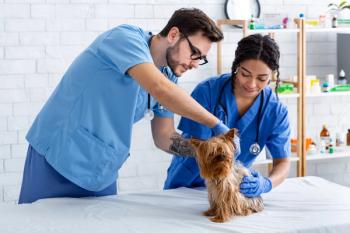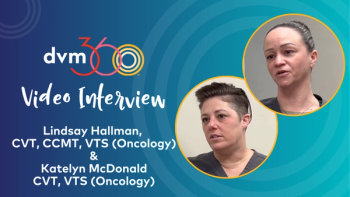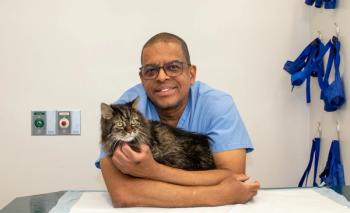
Veterinary teams talk frankly about getting bitten
It's the dirty little secret in veterinary practices: animal bites.
"Very honestly, getting bitten is part of the job," says Lindsay Bond, RVT, a technician at Gentle Care Animal Clinic in Lawrence, Kan. "You try your best not to, and you learn to know what to look for and how to avoid it. But it happens."
GETTYIMAGES/AGENCY ANIMAL PICTURE
While bites are not an uncommon occurrence in the field of veterinary medicine, what is significant are those things that happen around an injury. What happens afterwards? In addition to the physical effects, is there a psychological toll for technicians? How are the wounds viewed by the supervisors and doctors in the office? And what feelings do veterinary technicians attach to those times when their patients bite?
A very common response to a bite is for the technician to downplay the injury and to "tough-it-out" when it comes to seeking treatment.
"I don't focus too much attention when it happens," says Bond. "You just clean yourself off and move on."
"I usually just take care of it myself-get a band-aid or something," says Lindsey Morrison, RVT, a technician at Red Bridge Animal Clinic in Kansas City, Mo. Morrison did seek treatment once, when a severe case of cellulitis developed after a dog bit her. "I was pregnant and already had an appointment scheduled anyway," she says.
Along with the stoicism, though, are feelings that the technician missed a cue or that the bite could have been avoided if he or she had quicker reflexes or hadn't been distracted.
"Most bites happen because I made a mistake," says Morrison. "I usually think 'That was stupid!' or 'Why did I do that?'"
This willingness to feel responsible for these injuries could be an outgrowth from an industry that, in the past two decades, has emphasized veterinary care from the animal's perspective. More and more, veterinary clinics are creating animal-friendly environments designed to reduce animal anxiety, facilities like the Windsor Veterinary Clinic in Windsor, Colo., where Dr. Robin Downing has installed pheromone diffusers and replaced all of the florescent lighting in an attempt to relax fractious felines or calm cantankerous canines.
"Patients bite us because they are afraid, not because they are mean," says Dr. Downing. "These animals can't think their way out of their anxiety so they retreat into a 'strike first, ask questions later' kind of mentality."
Scared pets, risky business
While this stress-free approach to veterinary care has brought down the number of physical injuries, an unintended-and potentially harmful-effect could be on the veterinary technicians who not only feel responsible for injuries, but who also tend to downplay their severity.
Bond's most serious bite occurred about seven years ago, while working for a previous employer. A spaniel mix was undergoing a routine neutering procedure and bit her. "There was a problem with the anesthesia, and I guess maybe I took it for granted that he was not as coherent as he was," she says.
The bite left a large gash that involved the joints and tendons on her hand. Bond did not seek medical treatment immediately. Instead, she cleaned it up and put a little ice on it. The next day, when the pain and swelling had become more severe, the veterinarian sent her to the urgent care center, where her wound was properly cleaned and she was successfully treated with antibiotics.
Protecting the team
Discussions with technicians also reveal a high level of trust placed with the lead team members and veterinarians in the office and a strong desire to protect them. "You don't want the doctor to get bit!" says Morrison.
Not long ago, Julie Mullins, a Firstline Editorial Advisory Board member and lead trainer at Doggone Healthy in Calabash, N.C., was bit by a nervous Eskimo spitz as she tried to flip the lead over his head. The pain and surprise of the sudden bite caught her off guard. Only after the wound swelled and pus began oozing from the site did she seek treatment. A culture indicated that she had a MRSA infection, an increasingly common form of staph and so named because of its resistance to antibiotics.
"It was the first time I experienced any fear while in the industry," she says.
Mullins was shaken, not only from the pain, but from the realization that her fear could keep her from continuing to work in the profession. "You can't work in this industry without calm confidence," she says, adding that the fear stayed with her for quite some time.
Focus on cat bites
Recent research from the Mayo Medical School and Clinic indicates that cat bites, while sometimes benign in appearance, have the potential to be serious-especially when your hands are involved. (Learn more about the research at
Thirty percent of patients in the Mayo study who were treated for cat bites required hospitalization for intravenous antibiotic therapy, and, in many cases, surgical irrigation and wound debridement. Researchers found that wounds over a joint or tendon sheath were at the most risk for hospitalization, and they urged individuals who experienced pain and swelling after a cat bite to seek medical treatment.
Ironically, Dr. Downing, a veterinarian who has devoted her career to creating an animal-friendly environment for her patients, recently tweeted about an injury she received at work. It occurred while she was trimming the nails of Sylvester, a 20-year-old feline who has been her patient for over a decade. "It is more than a doctor-patient relationship," she says. "We are friends."
Nevertheless, her friend suddenly lashed out and bit her on her thumb. Dr. Downing's response sounded vaguely familiar. "It wasn't too serious because it was at the fleshy part of my thumb," she says, before adding that she must have missed a cue Sylvester provided. "I'm afraid I was distracted because I was talking to his mom ... I must have moved his leg into an awkward position or something."
Margie Carr is a freelance writer in Lawrence, Kan.
Newsletter
From exam room tips to practice management insights, get trusted veterinary news delivered straight to your inbox—subscribe to dvm360.




